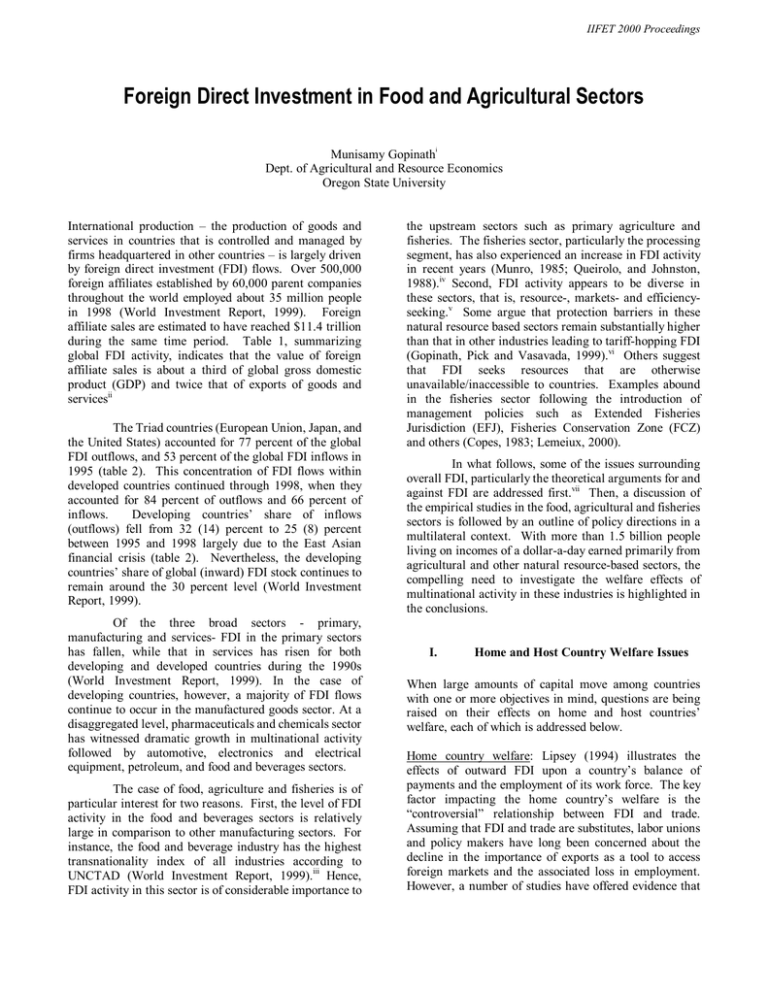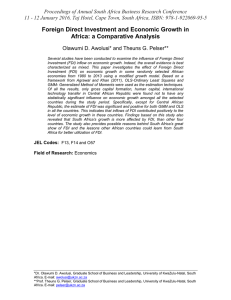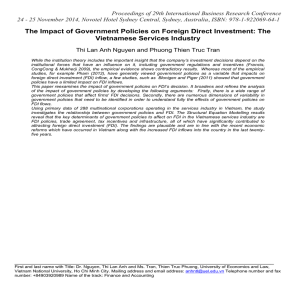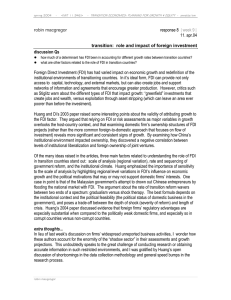Foreign Direct Investment in Food and Agricultural Sectors
advertisement

IIFET 2000 Proceedings Foreign Direct Investment in Food and Agricultural Sectors Munisamy Gopinathi Dept. of Agricultural and Resource Economics Oregon State University International production – the production of goods and services in countries that is controlled and managed by firms headquartered in other countries – is largely driven by foreign direct investment (FDI) flows. Over 500,000 foreign affiliates established by 60,000 parent companies throughout the world employed about 35 million people in 1998 (World Investment Report, 1999). Foreign affiliate sales are estimated to have reached $11.4 trillion during the same time period. Table 1, summarizing global FDI activity, indicates that the value of foreign affiliate sales is about a third of global gross domestic product (GDP) and twice that of exports of goods and servicesii The Triad countries (European Union, Japan, and the United States) accounted for 77 percent of the global FDI outflows, and 53 percent of the global FDI inflows in 1995 (table 2). This concentration of FDI flows within developed countries continued through 1998, when they accounted for 84 percent of outflows and 66 percent of inflows. Developing countries’ share of inflows (outflows) fell from 32 (14) percent to 25 (8) percent between 1995 and 1998 largely due to the East Asian financial crisis (table 2). Nevertheless, the developing countries’ share of global (inward) FDI stock continues to remain around the 30 percent level (World Investment Report, 1999). Of the three broad sectors - primary, manufacturing and services- FDI in the primary sectors has fallen, while that in services has risen for both developing and developed countries during the 1990s (World Investment Report, 1999). In the case of developing countries, however, a majority of FDI flows continue to occur in the manufactured goods sector. At a disaggregated level, pharmaceuticals and chemicals sector has witnessed dramatic growth in multinational activity followed by automotive, electronics and electrical equipment, petroleum, and food and beverages sectors. The case of food, agriculture and fisheries is of particular interest for two reasons. First, the level of FDI activity in the food and beverages sectors is relatively large in comparison to other manufacturing sectors. For instance, the food and beverage industry has the highest transnationality index of all industries according to UNCTAD (World Investment Report, 1999).iii Hence, FDI activity in this sector is of considerable importance to the upstream sectors such as primary agriculture and fisheries. The fisheries sector, particularly the processing segment, has also experienced an increase in FDI activity in recent years (Munro, 1985; Queirolo, and Johnston, 1988).iv Second, FDI activity appears to be diverse in these sectors, that is, resource-, markets- and efficiencyseeking.v Some argue that protection barriers in these natural resource based sectors remain substantially higher than that in other industries leading to tariff-hopping FDI (Gopinath, Pick and Vasavada, 1999).vi Others suggest that FDI seeks resources that are otherwise unavailable/inaccessible to countries. Examples abound in the fisheries sector following the introduction of management policies such as Extended Fisheries Jurisdiction (EFJ), Fisheries Conservation Zone (FCZ) and others (Copes, 1983; Lemeiux, 2000). In what follows, some of the issues surrounding overall FDI, particularly the theoretical arguments for and against FDI are addressed first.vii Then, a discussion of the empirical studies in the food, agricultural and fisheries sectors is followed by an outline of policy directions in a multilateral context. With more than 1.5 billion people living on incomes of a dollar-a-day earned primarily from agricultural and other natural resource-based sectors, the compelling need to investigate the welfare effects of multinational activity in these industries is highlighted in the conclusions. I. Home and Host Country Welfare Issues When large amounts of capital move among countries with one or more objectives in mind, questions are being raised on their effects on home and host countries’ welfare, each of which is addressed below. Home country welfare: Lipsey (1994) illustrates the effects of outward FDI upon a country’s balance of payments and the employment of its work force. The key factor impacting the home country’s welfare is the “controversial” relationship between FDI and trade. Assuming that FDI and trade are substitutes, labor unions and policy makers have long been concerned about the decline in the importance of exports as a tool to access foreign markets and the associated loss in employment. However, a number of studies have offered evidence that IIFET 2000 Proceedings FDI and trade may be complements both conceptually and empirically (Markusen, 1983; Lipsey and Weiss 1981). These studies have shown that differences in technology among countries, and growing foreign markets can cause FDI and trade to increase simultaneously. Moreover, firms extend their specific assets including knowledge, human capital and brand names, to produce abroad such that there is no loss in employment.viii II. Empirical Studies of FDI in Food and Agricultural Sectors In line with the concentration of investment flows, most of the studies on FDI effects deal with Triad countries (see Lipsey, 1994 for a comprehensive list of empirical work on manufacturing sectors). Few empirical studies have focused on the welfare effects of FDI flows in food, agriculture and fisheries sectors, some of which are reviewed in this section. As noted earlier, the FDI-trade relationship is at the core of the analysis of welfare effects of FDI on developed countries, while the rates of growth of GDP, trade and returns to capital are key welfare issues for developing countries. Host country welfare: FDI in developing countries has often been cast in a negative light. In further applying his “immiserizing growth” concept, Bhagwati portrayed FDI as “immiserizing” in several cases. Within the neoclassical model of international trade, Bhagwati has demonstrated the possibility of immiserizing growth caused by tariff-induced inflow of capital from abroad, assuming that the host country is small and continues to import the capital-intensive good while remaining incompletely specialized.ix Brecher and Diaz-Alejandro, (1977) extended this argument and confirmed that immiserization can be the only outcome from a tariffinduced inflow of untaxed capital from abroad. Developed Country studies: Food Sectors: The study by Gopinath, Pick and Vasavada (1999) analyzed the choices facing a multinational firm in supplying a foreign market - exports (produced in the home country) and overseas production. Their empirical framework consisted of a four equations system with foreign affiliate sales, exports, affiliate employment, and FDI as endogenous variables. Data on foreign activities (exports and foreign sales) of the U.S. processed food industry in ten developed countries for the time period 1982-94 were pooled to obtain a panel, which was then used to estimate the model. Markusen (1984) using a revealed preference analysis suggests that the welfare effects of FDI on host countries seem to involve a complicated tradeoff between increased technical efficiency (exploiting the foreign knowledge base) and the possibility of increased monopoly power. However, he demonstrates that competition among multinationals that keep prices near average costs of production is a sufficient condition for welfare gains in the host country. The results indicated that foreign sales and exports are substitutes in the U.S. processed food industry. This result differed from previous studies in this industry (Overend, Connor, and Salin; Malanoski, Handy, and Henderson) that have focused on the relationship between FDI (an input) and exports, rather than that of foreign sales and exports. While substitution suggests a loss of employment in the U.S. processed food industry, they suggest caution in interpreting this result because of the intensity of intermediate inputs used in this industry. Raw agricultural products and industrial inputs, such as packaging materials, preservatives and others, account for two-thirds of the total cost of production in processed food industry. Until more detailed data become available, the conjecture that substitution can be offset by exports of intermediates by multinationals to their foreign affiliates cannot be verified. As it stands, substitution between foreign sales and exports suggests that owners of capital in this industry stand to gain more relative to the work force. They also found empirical evidence that FDI was protection-jumping in this industry. Protection as measured by producer subsidy equivalents increased foreign sales, while reducing exports to foreign countries. New growth theory provides support for the thesis that FDI could be a potent factor in promoting growth. The exploitation of this potential, however, requires a conducive economic climate. In the absence of such a climate FDI may be counterproductive; it may thwart rather than promote economic growth, it may serve to enhance the private rate of return to investment by foreign firms while exerting little impact on social rates of return in the recipient economy. Because of all the inefficiencies it generates, an import substitution policy is unlikely to provide an economic climate conducive to the efficient operations of both domestic and foreign firms. The pervasive factor and product market distortions that it introduces may bias investment away from activities in which the country possesses a comparative advantage. Investment in activities in which the country does not possess a comparative advantage is more than likely to thwart the generation of human capital, increasing returns to scale and spillover effects: all of which, according to new growth theory, form the essential ingredients for economic growth. In contrast, the export promotion (outward-oriented) policy with its emphasis on neutrality, the free play of market forces and competition provides an ideal climate for the exploitation of the potential of FDI to promote growth.x Fisheries Sector: Following Munro’s (1985) seminal article several authors attempted to examine the impact of fisheries management policies (EFJ, FCZ) on trade and FDI in these sectors. A recent dissertation by Lemeiux (2000) investigates the possibility that firms bypass the “unintentional” trade barriers created by fisheries 2 IIFET 2000 Proceedings management policies through foreign direct investment. In the case of the Alaskan pollock industry, Lemeiux (2000) found an increasing level of Japanese investment following the passage of the 1976 Fisheries Conservation and Management Act and the eventual elimination of foreign harvesting and processing of Alaska pollock from United States controlled waters. Using a count data econometric procedure, Lemeiux (2000) analyzed the impact of changes in total allowable level of foreign fishing (TALFF) on the count of Japanese direct investments in Alaska, U.S. west coast states, and the entire U.S. fisheries sector. While TALFF had a distinct impact on Japanese FDI in U.S. west coast states, data limitations prevented Lemeiux (2000) from obtaining a comparable effect in Alaska. fruit and vegetable, corn milling, and oilseed milling industries, with the strongest increase in wheat milling (nearly 6 percent). The largest growth in agricultural production is expected in livestock and fruits and vegetables (about 8 percent). Despite the increase in domestic production caused by higher investment, there remains excess demand for processed foods that was generated by increased incomes and demand for processed foods. Most of the effect of the added investment appears as increased trade, when investment is broad based and allocated to its most economically viable use.xiii The above literature review is in no way comprehensive. Its purpose is to highlight some of the common themes among few empirical studies that investigated the welfare effects of FDI in food, agricultural and fisheries sectors. It is worthy to note here that a number of recent CGE type investigations have extended the concept of trade liberalization to account for FDI flows Developing Country Studies: Argentina: Reca and Abbott (1995) use a computable general equilibrium (CGE) model to project economywide effects of (i) trade liberalization and regional integration (MERCOSUR), (ii) increases in FDI, and (iii) increase in the level of technology (10 percent). In case (2), additional capital increased GDP growth rates, but returns to domestic capital declined. Exports and imports also increased as a result of FDI in the context of regional integration. Terms of trade improved, although by a smaller percent, since capital inflow needs to be matched by an increase in imports. The addition of capital makes capital less scarce than in the base case, thus the returns to capital drop following the capital inflow and technical change.xi III. Policy Directions United Nations Conference on Trade and Development (UNCTAD) argues that multinationals have made two important contributions to developing countries in two critical and related areas, the transfer of technology and the transformation of many countries from being exporters of primary commodities to being exporters of manufactures. Recognizing the dual role of multinationals, several developing countries have brought about regulatory changes including trade liberalization which are more favorable to FDI (World Investment Report, 1999). While stressing the need for a multilateral framework on investment, UNCTAD cautions that developing countries may not have necessary regulatory framework, and hence FDI can cause unintended impacts (excessive monopoly power, environmental degradation and others). Assuming that returns resulting from the FDI flow are not repatriated, food and agricultural output increase, but exports of dairy products and other processed foods increase at the expense of primary products and meat processing.xii Even with repatriation of funds, food and agriculture production and trade increased as FDI flows increased, but with an accompanied raise in the level of technology. Mexico: Burfisher, Robinson, and Thierfelder (1992) analyze the effects of the U.S./Mexico FTA on agriculture using a 25-sector, two country CGE model that explicitly models agricultural and food policies in both countries based on 1993 data. The effect of a 10-percent increase in the Mexican capital stock, through FDI, is simulated. Increased investment in Mexico’s general economy increases its demand for farm products from the United States. However, increased farm imports are not products directly used as inputs into Mexico’s processed food sectors. Rather, most of Mexico’s increased demand falls on feed grains and oilseeds. Thus, the expansion of Mexico’s meat and dairy industries stimulates Mexico’s livestock sectors and increases the demand for feeds. President Cardoso of Brazil in a summit meeting of developing countries held in New Delhi, India in 1996 viewed FDI in developing countries with caution. The Honorable Cardosa outlines a shift in policy in developing countries from controls and restrictions on the operations of transnationals in their markets to reformulating trade and economic policies to offer an attractive domestic environment for foreign investment. In his opinion, these countries face an interplay of global trends toward uniformity of rules and national identities. On one hand, economic globalization is linked to a revolution in production patterns leading to a significant shift in the comparative advantage of nations. On the other, the competitive advantage of a country is determined more and more by the quality of its human resources and by knowledge, science and technology applied to production Sectoral results in Mexico’s processed food industries predict a 4-5 percent increase in meat, dairy, 3 IIFET 2000 Proceedings methods. Abundant labor and raw materials are less and less a source of comparative advantage, to the extent that they represent a diminishing share of value added in virtually all products. These trends make it unlikely for countries in the South to succeed solely on relatively cheap labor and natural resources. The world of the 1990s is divided among those regions and countries, which participate in and share in the benefits of globalization and those, which do not. The former are generally associated with the idea of progress, improvement and wealth; the latter with exclusion, marginalization, and misery. For some developing countries like India and Brazil, integration into the global economy is pursued at the cost of greater domestic adjustment. For most developing countries, there is a question of whether these countries are condemned to living in absolute poverty -- to rely on foreign aid in a world less willing to provide it. Even countries who have partaken of globalization are faced with pockets of high unemployment and the ensuing social ills, a sentiment of exclusion, violence, xenophobic attitudes, and other social ills.xiv addressed the post-profit repatriation scenarios in developing as well as developed countries. In particular, it is not clear if the host country will gain after payments to foreign capital even under liberalized trade regimes. There is yet a lot of work to be done in this area, both conceptually and empirically. Conceptually, there is a need to identify conditions and factors which enhance the joint welfare of home and host countries. As with trade liberalization, effective transfer mechanisms (from winners to losers) may provide Pareto-superior solutions. Empirically, the biggest challenge is to assemble data on a consistent basis for all developing countries classified based on industry and country of origin. In addition to studies on competition among multinationals within a host country (a condition necessary for welfare gains in a host country), further testing for factors causing FDI and its consequences in dynamic settings is necessary for better understanding of the benefits of globalization through FDI. In recent years, the processed food industries have grown (when measured by their contributions to GDP) rapidly in several countries (Pacific Rim Outlook, 1998-1999), while agriculture continues to remain as a major employer in developing countries. With more than 1.5 billion people living on incomes of a dollar-a-day earned primarily from food, agricultural and fisheries sectors, the welfare effects of multinational activity have not been clearly identified. Specifically, the effect on returns to domestic resources (labor-skilled/unskilled, capital), and resources specific to agriculture need to be clearly identified. A continued investigation of the effects of multinational activity in these sectors is necessary in order to understand their role in economic development. IV. Conclusions and Implications While the debate on home and host countries’ welfare continues, most of the empirical studies in food and related sectors concluded that FDI was conducive to economic growth in developing countries, but substituted for trade in developed countries. Within host countries, industries shifted with the reallocation of resources, causing some to grow more rapidly and others to disappear, as with trade liberalization. FDI has a stronger effect on growth and trade when combined with trade liberalization. However, only a few studies have 4 IIFET 2000 Proceedings Table 1. Selected indicators of FDI and international production, 1986-1998 (Billions of dollars and percentage) Item Value at current prices Annual-growth rate (Billion dollars) (Percent) 1997 1998 359 380 3086 3145 163 9372 464 475 3437 3423 236 9728a Gross product of foreign affiliates Total assets of foreign affiliates 2026 11246 2286a 12211a Exports of foreign affiliates Employment of foreign affiliates (thousands) 1841a 30941 2035a 31630a 644 649 4088 4117 411 1142 7c 2677c 1462 0c 2338c 3507 4c 29024 6072 57 6523 29360 5917 60 6710 .. .. .. 6576c FDI inflows FDI outflows FDI inwards stock FDI outflows stock Cross-border M&As Sales of foreign affiliates Memorandum GDP at factor cost Gross fixed capital formation Royalties and fees receipts Exports of goods and non-factor services 1996 19861990 1996 1997 24.3 27.3 17.9 21.3 21.0b 16.6 1991 1995 19.6 15.9 9.6 10.5 30.2 10.7 9.1 5.9 10.6 10.7 15.5 11.7 29.4 25.1 11.4 8.9 45.2 3.8c 38.7 36.6 19 20.3 73.9 17.5c 16.8 18.5 7.3 13.8 6.7 8.8 12.8c 8.6c 17.1c 19.7c 13.5 5.9 13.1 5.6 -5.8c 4.9 10.5c 2.2c 14.9c 10.9c 12.0 12.1 22.4 15.0 6.4 6.5 14.0 9.3 2.5 2.5 8.6 5.7 1.2 -2.5 3.8 2.9 .. .. .. -2.0c 1998 Source: UNCTAD, World Investment Report 1999: Foreign Direct Investment and the Challenge of Development, Table 1.2, p.9. a Majority-held investments only. b 1987-1990 only. c Estimates. 5 IIFET 2000 Proceedings Table 2. Regional distribution of FDI inflows and outflows, 1995-1998 (percentage) Developed countries 1995 63.4 Inflows 1996 1997 58.8 58.9 1998 71.5 1995 85.3 Outflows 1996 1997 84.2 85.6 1998 91.6 Western Europe European Union Other Western Europe United States Japan 37.0 35.1 1.9 17.9 - 32.1 30.4 1.8 21.3 0.1 29.1 27.2 1.9 23.5 0.7 36.9 35.7 1.2 30.0 0.5 48.9 44.7 4.2 25.7 6.3 53.7 47.9 5.8 19.7 6.2 50.6 46.0 4.6 23.1 5.5 62.6 59.5 3.1 20.5 3.7 Other developed countries Developing countries 8.5 32.3 5.3 37.7 5.6 37.2 4.1 25.8 4.4 14.5 4.6 15.5 6.4 13.7 4.9 8.1 Africa Latin America and the Caribbean Developing Europe Asia West Asia Central Asia South, East and SE Asia The Pacific Central and Eastern Europe 1.3 10 .0 1.6 12.9 1.6 14.7 1.2 11.1 0.1 2.1 1.9 0.3 3.3 0.1 2.4 0.1 20.7 -0.1 0.4 20.4 0.2 4.3 0.3 22.9 0.2 0.6 22.1 0.1 3.5 0.2 20.6 1.0 0.7 18.9 4.0 0.2 13.2 0.7 0.5 12.0 2.7 12.3 -0.2 12.5 0.1 13.6 0.6 13.0 0.3 0.1 10.0 0.4 9.6 0.7 5.6 0.3 5.3 0.3 100 100 100 100 100 100 100 100 World Source: UNCTAD, World Investment Report 1999, Foreign Direct Investment and the Challenge of development, table I.3, p.20. Gopinath, M., D. Pick, and U. Vasavada. “The Economics of Foreign Direct Investment andTrade with an Application to the U.S. Food Processing Industry.” American Journal of Agricultural Economics, 81(May 1999): 442-52. References Bhagwati, Jagdish. “Immiserizing Growth,” Chapter 12, Political Economy and International Economics, edited by Douglas A. Irwin MIT Press, Cambridge, MA, 1996 Brecher, Richard, and F. Diaz-Alejandro. “Tariffs, Foreign Capital and Immiserizing Growth,” Journal of International Economics, Vol. 7 (1977), pp. 317-322. Gopinath, M., D. Pick, and U. Vasavada. “Exchange Rate Effects on the Relationship between FDI and Trade in the U.S. Food Processing Industry.” American Journal of Agricultural Economics, 80(December 1998): 1073-79. Burfisher, Mary, Sherman Robinson, and Karen Thierfelder. “Agricultural and Food Policies in a United States-Mexico Free Trade Area,” North American Journal of Economics and Finance. Vol. 3 No.2, (1992) pp.11739. Lemieux, J. Fisheries Management Policies and Japanese Direct Investment in the Alaska Pollock Fishery. M.S. Dissertation, Oregon State University, May 2000. Lipsey, R.E., and M.Y. Weiss. “Foreign Production and Exports in Manufacturing Industries.” Review of Economics and Statistics Vol. 63 (1981), pp. 488-94. Cardosa, H.E. Fernando Henrique. “Social Consequences of Globalization, Marginalization or Improvement,” presented at the Indian International Center, New Delhi, 1996. Http://www.brasil.emb.nw.dc.us/fpst06gl.htm Lipsey, R.E. Outward Direct Investment and U.S. Economy, Working Paper No. 4691, Cambridge MA: National Bureau of Economic Research, 1994. Copes, P. Extended Jurisdiction and its Effects on World Trade in Seafood. Proceedings of the International Seafood Conference, Alaska Sea Grant Report No. 83:2741, 1983. 6 IIFET 2000 Proceedings Malanoski, M., C.R. Handy, and D. Henderson. “Time Dependent Relationships in U.S. Processed Trade and Foreign Direct Investment.” in Henneberry, S. R.(ed.) Foreign Direct Investment and Processed Food Trade: Proceedings of the Conference of NCR182. Oklahoma State University, 1997. Pacific Economic Council. Pacific Food Outlook, 19981999. Pacific Economic Cooperation Council, Singapore, 1999. Queirolo, L. E., and R. S. Johnston. Some Economic Consequences of Extended Jurisdiction for Cooperative Fishing Arrangements. Proceedings of the Fourth Biennial Conference of the International Institute of Fisheries Economics and Trade, Esbjerg, Denmark, Aug. 1998, Vol I: 763-777. Markusen, J. R. “Factor Movements and Commodity Trade as Complements.” Journal of International Economics Vol. 4, (1983), pp.341-356. Munro, G.R. “Coastal States, Distant Water Fleets, and Extended Fisheries Jurisdiction: Some Long-run Considerations.” Marine policy, 9:2-15, 1996. Reca, Alejandro, and Philip C. Abbott. “Foreign Direct Investment and Regional Integration: Mercosur and Argentine Processed Food Trade.” Paper presented at the NCR-182 Conference on Foreign Direct Investment and Product Food Trade, Washington, DC, March 9-10, 1995. Overend, C., J.M. Connor and V. Salin. “Foreign Direct Investment and US Exports of Processed Foods: Complements or Substitutes?” in Henneberry, S. R.(ed.) Foreign Direct Investment and Processed Food Trade: Proceedings of the Conference of NCR-182. Oklahoma State University, 1997. Ruffin, R.J. “International Factor Movements.” in Jones, R.W. and P.B. Kenen (eds.) Handbook of International Economics, Amsterdam: North-Holland, 1984. World Investment Report, United Nations Conference on Trade and Development, New York, 1999. i Assistant Professor, Department of Agricultural and Resource Economics, Oregon State University. Research assistance from Weiyan Chen is acknowledged. Materials from an earlier study, “Effects of FDI in Developing Countries: The Case of Food and Agriculture,” by C.H. Bolling and M. Gopinath served as a basis for some of the following sections. ii Intra-firm transfers account for a third of the value of exports of goods and services. iii Transnationality index is a weighted average of three ratios - foreign assets/total assets, foreign sales/total sales, and foreign employment/total employment. iv While agriculture per se does not attract large FDI flows, related sectors such as chemicals (fertlizers, pesticides), seeds, and farm machinery are components of other sectors, which have witnessed rapid growth in multinational activity. v These definitions of FDI activity are parallel to the ownership, location and internalization (OLI) paradigm. vi Evidence that foreign affiliate sales by U.S. Majority-owned food subsidiaries is four times the value of processed food exported by the United States appear to offer some credibility to this argument. vii Given the breadth and depth of the FDI literature, the focus here is on some major contributions. A review of literature is beyond the scope of this paper (see Ruffin, 1984 for a survey). viii Note transportation costs and other barriers may totally preclude exports. In this case, the extension of firm-specific assets does not necessarily cause a loss of employment in home country. ix Non-economic arguments against FDI raise questions of sovereignty, destabilization, and cultural values. While couched in terms of economic theory, Bhagwati voiced the fears of many of the developing world who had a legacy of colonialism and exploitation, and a model of extractive industries that left the native populations impoverished. x There are areas that are not dealt with in these studies that add controversy to the subject of FDI. Many of them are environmental issues, such as saving the California redwoods, the whale nurseries of Mexico, the rain forests of Brazil and many others that involve the destruction of priceless natural resources. xi These effects are reinforced with an increase in the level of technology (case iii), presumably through FDI. xii Argentina’s overall GDP did not necessarily increase in the scenario of repatriation of earnings from FDI, but exports increased in comparison to the base scenario when FDI and technology are included. xiii Some of the effects on trade may arise from the stock and flow effects of FDI on exchange rates. FDI inflows may appreciate a country’s exchange rate, but it finances the addition of capital stock. When profits are repatriated it would tend to depreciate the exchange rate, but there is a larger stock of capital, which should help to pay for the outflow of profits. xiv President Cardoso’s view resembles that of development economist Raul Prabisch on specialization in primary products, which at one time was mainstream in Latin America. 7






